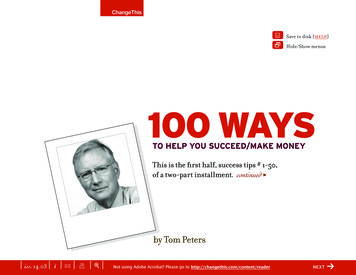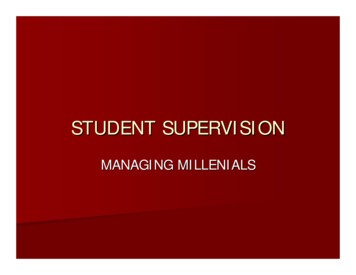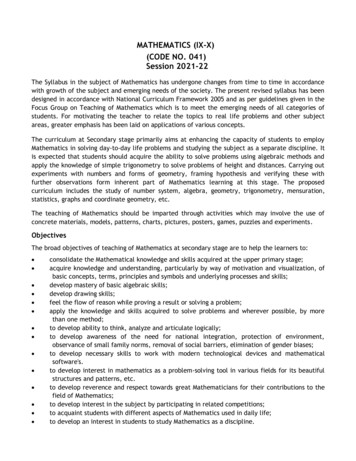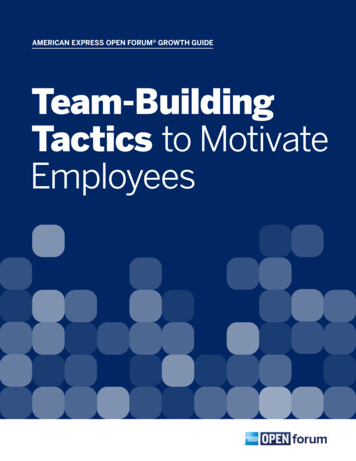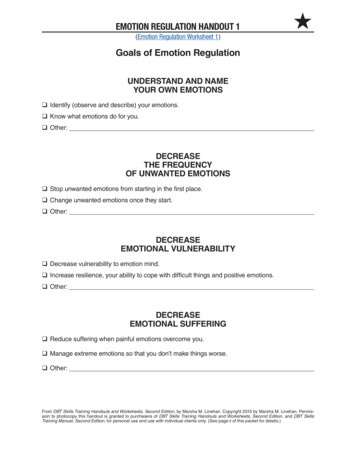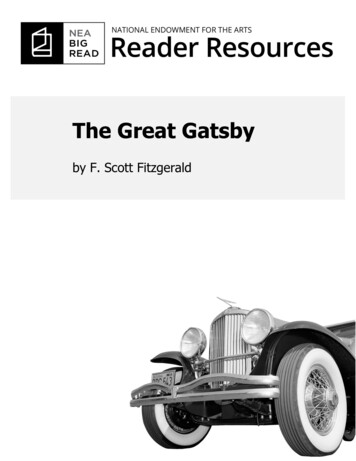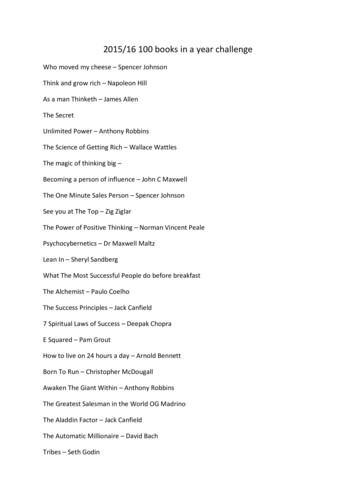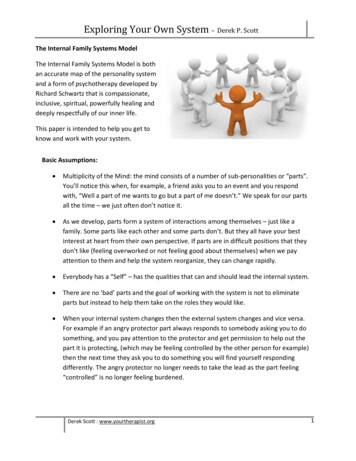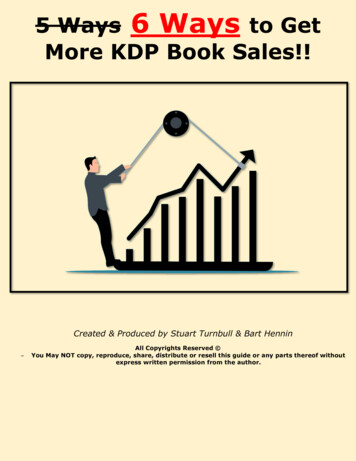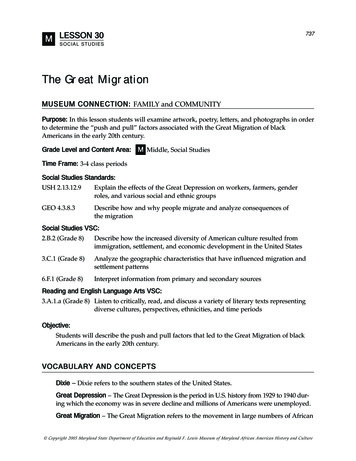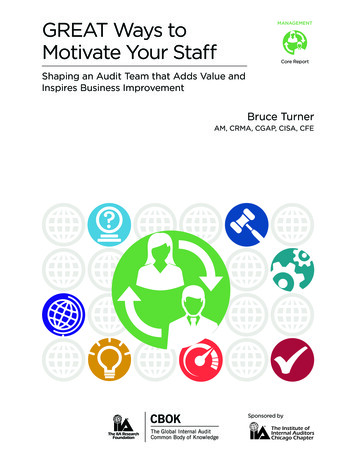
Transcription
GREAT Ways toMotivate Your StaffMANAGEMENTCore ReportShaping an Audit Team that Adds Value andInspires Business ImprovementBruce TurnerAM, CRMA, CGAP, CISA, CFECBOKThe Global Internal AuditCommon Body of KnowledgeSponsored by
About CBOKTSURVEY PLOYEE LEVELSChief auditexecutive (CAE) 26%Director13%Manager17%Staff44%*Response rates varyper question.he Global Internal Audit Common Body of Knowledge (CBOK) is the world’slargest ongoing study of the internal audit profession, including studies of internal audit practitioners and their stakeholders. One of the key components of CBOK2015 is the global practitioner survey, which provides a comprehensive look at theactivities and characteristics of internal auditors worldwide. This project builds on twoprevious global surveys of internal audit practitioners conducted by The IIA ResearchFoundation in 2006 (9,366 responses) and 2010 (13,582 responses).Reports will be released on a monthly basis through July 2016 and can bedownloaded free of charge thanks to the generous contributions and support fromindividuals, professional organizations, IIA chapters, and IIA institutes. More than25 reports are planned in three formats: 1) core reports, which discuss broad topics,2) closer looks, which dive deeper into key issues, and 3) fast facts, which focus on aspecific region or idea. These reports will explore different aspects of eight knowledgetracks, including technology, risk, talent, and others.Visit the CBOK Resource Exchange at www.theiia.org/goto/CBOK to downloadthe latest reports as they become available.CBOK 2015 Practitioner Survey: Participation from Global RegionsEuropeNorthAmerica 19%Middle East& North8%AfricaLatinAmerica 14%& & Pacific6%Note: Global regions are based on World Bank categories. For Europe, fewer than 1% of respondents were from Central Asia.Survey responses were collected from February 2, 2015, to April 1, 2015. The online survey link was distributed via institute emaillists, IIA websites, newsletters, and social media. Partially completed surveys were included in analysis as long as the demographicquestions were fully completed. In CBOK 2015 reports, specific questions are referenced as Q1, Q2, and so on. A complete list ofsurvey questions can be downloaded from the CBOK Resource Exchange.2 GREAT Ways to Motivate Your Staff
GovernanceManagementRiskExecutive Summary4Introduction51Goal Setting72Retaining Talent3Equipping Employees204Assessing Performance245Treating Success2812Closing Comments32Appendix A: Motivation from A to Z33Appendix B: Resources34Standards /CBOK 3
Executive SummaryThe most effective chief audit executives (CAEs) position their internal audit departments to add value andinspire business improvement by maximizing the productivity and contribution of their internal audit cohort.But how do they: Set goals that inspire auditors todeliver insights that matter? Boost productivity withappropriate rewards? Address differences betweengenerations?This report provides GREAT insights on how CAEsand other audit leaders can improve their practices forevaluating and motivating internal auditors.You will learn strategies for:4 Goal Setting: Align personal goals of internalauditors to internal audit department goals andthe organization’s strategies. Retaining Talent: Retain talent amidst changing needs of internal audit and the business. GREAT Ways to Motivate Your Staff Equipping Employees: Build capabilityand capacity for internal audit overall andindividually. Assessing Performance: Evaluate internalauditors against overall internal audit department performance. Treating Success: Provide incentives and recognition to motivate internal auditors.Plus, you will also learn the implications of generationaldifferences among Baby Boomers, Generation X, andMillennials in the internal audit workforce.Finally, insights are shared from the CBOK 2015Global Internal Audit Practitioner Survey, the largestongoing study of internal auditors in the world.
IntroductionThis report provides broad insights on how CAEs andother internal audit leaders evaluate and motivatetheir employees, and how these processes can be improvedand are expected to change during the coming years.Leading CAEs recognize that: They need to shape a motivated and highlyproductive internal audit workforce that delivers value to the business. Stakeholder expectations for internal audit willcontinue to evolve. The motivation of internal auditors can beinfluenced by a wide range of factors, including life satisfaction across the course of one’slife, generational differences, and uniquegender needs.Objectives and BenefitsGREAT Ways to Motivate Your Staff provides five strategiesfor integrated performance management that are tailoredspecifically for the internal audit profession. Exhibit 1describes each strategy, its objective, and its benefit.10 Action ItemsEvery strategy needs action to go with it, so this reportincludes 10 action items for you to implement (seeexhibit 2). The concepts are scalable and can be consolidated into simpler plans and programs for smaller internalaudit departments. In addition, look for opportunities totake advantage of established organization-wide programsthat can be aligned with your motivational strategies.Exhibit 1 GREAT Ways to Motivate Your Staff: Objectives and BenefitsStrategyObjectiveBenefitGoal settingAlign personal goals of internal auditorsto internal audit department goals and theorganization’s strategies.Help the organization meet itsobjectives.Retaining talentIdentify talent amidst changing needs ofinternal audit and the business.Build an effective internal audit team.Equipping employeesBuild capability and capacity for internal auditoverall and individually.Deliver value.AssessingperformanceEvaluate internal auditors against overallinternal audit department performance.Drive optimal contribution by theinternal audit department.Treating successProvide incentives and recognition to motivateinternal auditors.Boost internal audit productivity.Source: Author’s creation.www.theiia.org/goto/CBOK 5
Exhibit 2 GREAT Ways to Motivate Your Staff: 10 Action ItemsStrategyAction ItemsGoal setting1. Undertake formal analysis of the organization's strategy.2. Align internal auditors' personal goals with the organization's strategy.Retaining talent3. Establish a talent management strategy.4. Adapt motivation strategies to the different generations.Equipping employees5. Establish a comprehensive workforce plan.6. Develop and implement a professional development plan.Assessing performance7. Adopt balanced scorecard reporting (or a similar dashboard).8. Implement a constant feedback and learning loop for internal audit.Treating success9. Establish a rewards system that extends beyond compensation.10. Develop an employee engagement model.Source: Author’s creation.6 GREAT Ways to Motivate Your Staff
1Goal SettingAlign personal goals of internal auditors to internal auditdepartment goals and the organization’s strategies to help theorganization achieve its objectives.Action Items Undertake formal analysis of the organization’s strategy. The best way to do this is to establisha stakeholder relationship management program so that you can better understand the businessdrivers, pressures, and strategies of the organization in establishing the audit plan. Align internal auditors’ personal goals with the organization’s strategy. First, ensure there isalignment between the personal performance goals and objectives of internal auditors and themission, objectives, and audit plan of the internal audit department (which should already be alignedwith the strategic direction of the organization). Second, extend this analysis into external researchof industry trends, emerging risk issues, and other hot topics, which lead to incorporating suitabletopics in the audit plan.IntroductionInternal auditors play a key role in enhancing and protecting organizational value and helping organizationsaccomplish their objectives. They are in a much moreeffective position to help an organization accomplish itsobjectives when their personal performance goals andobjectives align to the mission and objectives of the internal audit department, which in turn is aligned with thestrategic direction of the organization. Exhibit 3 showsthis relationship.Resources Used to Establish Audit PlansThe resources (or sources, as some regions would say) usedto establish audit plans are varied, and they embrace thecore pillars of consultation, analysis, and research.Most respondents use a risk-based methodology (85%)and through consultation draw in requests from key stakeholders (including management 72%, divisional heads62%, and audit committees 56%). Through analysis theythen reflect back on the previous year’s audit plan (61%).Around 64% of CAEs report that they are undertakinganalysis of the organization’s strategy or business objectivesExhibit 3 Individual Goals Contributing toStrategic ��sMission : The individual goals of internal audit staff should alignwith internal audit’s mission and objectives. This will ultimatelyhelp to achieve the organization’s strategic objectives.www.theiia.org/goto/CBOK 7
Aligning Internal Audit with the Organization’sStrategywhen establishing their audit plan (see exhibit 4). In addition to these factors, leading CAEs also undertake researchthat considers external factors such as industry trends,emerging risk issues, and other hot topics (however, theseexternal factors were not included as response options inthe survey question).About 57% of CAEs report that their internal auditdepartment is fully aligned or almost fully aligned withthe strategic plan of their organization; the remaining43% are somewhat, minimally, or not aligned with thestrategic plan of their organization (see exhibit 5). Amongthe seven CBOK regions, Latin America & Caribbean(72%) and Sub-Saharan Africa (69%) report the mostaligned. Leading CAEs find that effective stakeholderengagement arrangements help to optimize the alignmentbetween the internal audit plan and the strategic plan ofthe organization.Leadership Insight“As we rise to meet new challenges, wemust focus on the opportunities that willhelp us overcome these obstacles. Wemust focus on becoming better prepared,better informed, and fully engaged withstakeholders.”Individual Goal Setting for Internal Auditors—Anton van Wyk, Partner,PricewaterhouseCoopers South Africa,Immediate Past Chairman IIA Global BoardGoal setting is a key part of a performance managementprocess that aligns each staff member’s personal goals todepartmental and organizational goals and objectives. InExhibit 4 Resources Used to Establish Audit Plans85%Risk-based methodology72%Requests from managementAnalysis of the organization's strategy orbusiness objectives64%Compliance/regulatory requirements62%Consultations with divisional or business heads62%Previous year's audit plan61%56%Requests from the audit committee26%Consultations with external auditors19%Requests from external auditorsOther 6%0%20%Analysis40%Consultation60%80%Other (which could include research)Note: Q48. What resources do you use to establish your audit plan? Choose all that apply. CAEs only. n 3,040.8 GREAT Ways to Motivate Your Staff100%
Exhibit 5 Internal Audit Aligned with theStrategic Plan of the OrganizationMinimallyaligned ornot aligned8%Somewhataligned35%Fully alignedor almostfully aligned57%Note: Q57: To what extent do you believe your internalaudit department is aligned with the strategic plan of yourorganization? CAEs only. n 2,756.a four-stage performance management process (as illustrated in exhibit 6), the individual’s performance appraisalconsiders the outcomes achieved against the goals set atthe start of the process. In turn, the appraisal outcomefeeds into the internal auditor’s proposed professionaldevelopment activities and will influence any intrinsic andextrinsic rewards.The establishment of individual goals is an iterative process between the auditor and the CAE or their delegate.The aim is to identify the specific results that the individual auditor is required to achieve to help the internal auditdepartment (and ultimately the organization) achieve itsobjectives. In effect, over a typical 12-month cycle, theauditor’s performance goals are discussed and agreed, theauditor takes action to achieve the goals, performance isappraised, goals are refreshed, and, where appropriate,performance improvements are identified.Depending on the organization’s human resources policies, the goals may well be a combination of work-specificoutcomes and personal development needs. (Personaldevelopment plans are described in more detail in chapter3, “Equipping Employees.”)It is very important to have clear documentation of thelink between individual goals, departmental goals, andorganizational goals. Exhibit 7 shows how you can linkbalanced scorecard elements, departmental key performance indicators (KPIs), and individual performance forleaders or staff. If you do not use the balanced scorecardprocess, you can substitute a similar performance dashboard. This process is also discussed further in chapter 4,“Assessing Performance.”Leadership Insight“Internal auditors can be best positionedas strategic advisors to their executives.To do this, they need to fully understand the business drivers, pressures, andstrategies.”—Frances Cawthra, Chief Finance Officer,Australian Taxation Office, AustraliaExhibit 6 Typical Elements of a Performance Management ProcessGoal Rewardwww.theiia.org/goto/CBOK 9
Exhibit 7 Example of Aligning Individual Performance Measures to Balanced Scorecard gwith theauditcommitteeSupportingexecutiveand seniormanagementManaginginternal auditprocessesManaginginternalauditorsand theirdevelopmentExamples of DepartmentalKey Performance Indicators (KPIs) Audit LeadersAuditorsAudit committee expectations metQualitativeYesIf directlyrelevantPercentage of audit plan completeQuantitativeYes for ownteamYes for personalallocationClient satisfaction goals—value addedQualitativeYes for ownteamYes for ownauditsClient satisfaction goals—usefulness ofrecommendationsQualitativeYes for ownteamYes for ownauditsCycle times (duration period of audits)QuantitativeYes for ownteamYes for ownauditsPerformance against the internal auditfinancial budgetQuantitativeApplies to CAENot applicableMaintain current internal audit charter,intranet, audit manualQualitativeApplies to CAENot applicableBudget to actual audit timesQuantitativeYes for ownteamYes for ownauditsConformance with quality assuranceand improvement standards (based oninternal and external quality assessments)QualitativeYes for ownteamYes for ownauditsInternal auditor workforce satisfactionQualitativeYes for ownteamNot applicableCompletion of initiatives in professionaldevelopment planQuantitativeYes for ownteamYes personallyOptimizing utilization of internal auditresources (to conduct audits whileminimizing "administration")QuantitativeYes for ownteamYes personallySource: Author’s creation.10MeasureTypeGREAT Ways to Motivate Your Staff
Six Key Strategies for Goal SettingConclusionBased on insights from experienced CAEs, here are six keystrategies for effective goal setting:Effective goal setting provides the road map for internalauditors to consistently deliver insights that really matter.CAEs rely on the talent at their disposal to determineinsights that add value to their organization and help itachieve its objectives. The next chapter is about retainingtalent. It illustrates how individual characteristics make abig difference in how you approach goal setting by exploring generational, life satisfaction, and gender differences.Don’t assume that everyone on your staff can be motivatedthe same way!1. Provide sufficient time for audit leaders andauditors to develop and agree upon goals.2. Establish meaningful goals that are clear,measurable, and achievable.3. Set goals that are commensurate with anauditor’s capability.4. Align individual goals to audit departmentand organizational strategy.5. Equip auditors with the necessary skills tomeet goals.6. Provide auditors with motivation to meet goals.Be sure to take each of all six strategies into consideration for each individual. This will help you pave the wayfor each person to succeed.Leadership Insight“In order to have an efficient internal auditdepartment, internal audit team membersmust have clear goals and personal objectives defined together with the CAE, whohas the responsibility to ensure that thesegoals and objectives are fully aligned withthe goals assigned to his department. Theaddition of personal goals should achieveor exceed the collective goals of the internal audit department.”—Jean-Marie Pivard, Vice President,Internal Audit and Risk Management,Publicis Group, Francewww.theiia.org/goto/CBOK 11
2Retaining TalentRetain the right talent amidst changing needs of internal audit andthe business to help build an effective internal audit team.Action Items Establish a talent management strategy that promotes innovation and aligns with stakeholderneeds, diversity ideals, audit plans, a competency gap analysis, and succession plans. Adapt motivation strategies to the different generations (Baby Boomers, Generation X,Millennials, and the upcoming Generation Z).IntroductionGenerational differences affect all elements of workforcemanagement, including recruitment, team building,management, motivation, change management, andoptimization of productivity. Effective generationalmanagement helps to drive communication strategies,gain employee commitment, minimize employee turnover, reduce misunderstandings, and attract high caliberemployees.As Jean-Marie Pivard, vice president internal audit andrisk management at Publicis Group, France, explained,“The way to manage an internal audit function tomorrowwill considerably change compared to nowadays as a resultof the major changes in the mindset and behavior of newgenerations.”In terms of retaining talent, this chapter explores theimpact of: Generational differencesLife satisfaction factorsInternal audit retention patternsGenderRotation programsMotivation Strategies that RecognizeGenerational DifferencesAs CAEs pursue creative talent management strategies,they need to recognize the different motivational driversthat exist among the generations.12 GREAT Ways to Motivate Your StaffIn the main, there are five generations that make upthe bulk of the workforce today and into the near future:Traditionalists (70 to 88 years old), Baby Boomers (51to 69 years old), Generation X (35 to 50 years old),Millennials, also known as Generation Y (15 to 34 yearsold), and Generation Z (younger than 15). Traditionalistsand Baby Boomers often held “a job for life,” and thisprovided structural, career path, and staffing stabilityfor CAEs because they had a pool of career auditors.Generation X and Millennials are expected to change jobsor careers more frequently. Finally, the technologysavvy Generation Z will bring a new perspective to theworkforce in future years. Exhibit 8 provides a summaryof the characteristics commonly associated with thesegenerations.The differences among generations is a theme throughout this report. You will learn about the generationalrepresentation in the internal audit profession, includingstaff levels (exhibit 10), years of experience (exhibit 11),and intentions to stay in the profession (exhibit 12). Inaddition, you will learn about generational preferences forlearning styles (exhibit 18), feedback loops (exhibit 20),intrinsic rewards (exhibit 21), and employee engagementfeatures (exhibit 22). Collectively, these exhibits provideinsights on features that need to be considered in theestablishment of strategies that motivate people from different generations.
Exhibit 8 Generational CharacteristicsTraditionalistsBaby BoomersGeneration X(Gen X)Millennials(Generation Y)Generation ZBirth YearRange1927 to 19451946 to 19641965 to 19801981 to 2000After 2000Current age(for 2015)70 to 8851 to 6935 to 5015 to 34Younger than 15Key influencesThe GreatDepressionBrought up inan abundant,healthy, postWorld WareconomyWitnessedparentssacrificinggreatly for theircompaniesRaised duringthe boom times;strong parentalsupportBorn afterinvention ofInternet, sohyper techsavvyCommon valuesWorking hardWorkingefficientlyEliminating ticismRealismEnthusiasmRespect forauthorityWorthy ng withrulesQuestioningauthoritySelf-relianceBeing sociableAvoiding riskDuty before funPersonalfulfillmentFunLots of funLess-developedsocial skillsIndividualTeam elfishIndependentIndependentPerforms well inteamsTechnologicallyintuitiveDependableValues flexibilityStructured andlinearNonlinearGlobalperspectiveNeeds structureand guidanceLess-developedcritical thinkingGeneral traitsSeeks jobsecurityPreferences forrecognitionA thank stant andimmediatefeedbackLots of periodicawards/rewardsExamples ofmessages thatmotivateYour experienceis respected.You are neededand valued.Do it your way.You will workwith otherbright, creativepeople.You will haveadvancementopportunities.Note: The content of this exhibit is intended to provide illustrative examples of general patterns and reflects just a small proportionof reported characteristics. It was developed by the author from a range of Internet searches, and refined during consultation withglobal business, finance, and audit leaders. The age ranges and descriptors are indicative only and vary in different publications.www.theiia.org/goto/CBOK 13
Generational Impacts on Internal AuditGeneration X makes up half of the internal audit profession worldwide. Another 3 out of 10 are Millennials, and2 out of 10 are Baby Boomers (see exhibit 9). The generational breakout by staff level shows that management isclearly weighted toward Generation X. Those below management level are fairly evenly split between Generation Xand the Millennials, with slightly more Millennials as theyare starting their careers (see exhibit 10).Exhibit 10 Generation Compared to Staff g for Baby Boomer RetirementCAEs need to remain abreast of the retirement plans ofBaby Boomers. According to the CBOK practitionersurvey, 24% of them expect to retire in the next five years(Q36, n 11,107). Retirement of this group of employeeswill result in the loss of well-tuned communication skillsand significant workplace experience. As exhibit 11 shows,42% of Baby Boomers have more than 15 years of auditexperience, compared to only 18% of Generation X.When Baby Boomers retire, CAEs will also lose some oftheir internal audit function’s knowledge base. Therefore,CAEs should leverage the experience, loyalty, and credibility of Baby Boomers by asking them to train newer staff.Some Baby Boomers may also welcome the chance to support such programs post-retirement. In addition, when astaff member is near retirement, CAEs should take steps to57%55%Staff14%ManagerBaby Boomers(ages 51-69)9%Director orCAE (ChiefSenior Manager Audit Executive)or EquivalentMillennials(ages 19-34)Generation X(ages 35-50)Note: Q9: What is your position as an internal auditor in yourorganization? Due to rounding, some totals may not equal100%. n 11,241.Exhibit 11 Years of Experience Compared toGeneration80%66%60%51%Exhibit 9 Generations Among InternalAuditors Surveyed40%Traditionalists(70 or older)0.2%34%Generation X(ages 35-50)50.1%0%42%31%18%20%Millennials(ages 19-34)30.1%Baby Boomers(ages 51-69)19.6%37%21%0%Millennials(ages 19-34)0 to 5Generation X(ages 35-50)6 to 14Baby Boomers(ages 51-69)15 or moreNote: Q3: What is your age? compared to Q10: Approximatelyhow many years of professional experience do you have as aninternal auditor? n 11,607.Note: Q3: What is your age? n 11,241.14 GREAT Ways to Motivate Your Staff
retain the knowledge stored in the employee’s digital files.One option is to ask the employee to provide a package oftheir most valuable documents along with a description oftheir usage.Finally, Baby Boomers are at an ideal level to assumeaudit committee roles for other entities. This providesaudit committees with experienced practitioners (bothbefore and after their retirement) who will be strong advocates for the profession.Grooming Millennials for LeadershipGeneration X has been assuming internal audit leadership roles as Baby Boomers shift into other roles or retire.About 57% of CAEs are now from Generation X, as illustrated in exhibit 10.Millennials currently hold nearly half of all the internalaudit staff roles and a small proportion of CAE roles (9%).As generational changes take effect, Millennials will moveinto management positions, so CAEs are investing in theleadership development of Millennials.In addition to established training programs, CAEsare looking to innovative solutions that cultivate insightful, proactive, and future-focused leadership thinking.Examples of these solutions are: Having Millennials lead lower risk auditengagements Allowing them to attend important meetings(as observers) with senior management andaudit committees Sending them into the business on short-termsecondments (when an employee temporarilytransfers to another job for a defined period oftime for a specific purpose to the mutual benefit of all parties) Using a frontline connections program wherethey spend several hours a month observingfrontline operatives and/or leaders Having them connect with internal auditalumni for periodic informal interactions Offering mentoring or coaching opportunitiesPreparing for Generation Z to Enter the WorkforceProgressive leaders will already be considering the uniqueneeds of the technology-savvy Generation Z entering theworkforce in the near future. This generation of digitalnatives has grown up with information at their fingertips.They are adept at sourcing, deciphering, and sharing information from across the world. They are likely to beattracted by education and training programs. Once in theworkforce, they are likely to prefer more personal forms ofcommunication such as employee profiles and stories.Leadership Insight“I hope audit leaders, and those lookingto become leaders, will invest in learningabout the power of diversity and unconscious bias. Doing so will help their auditteam (and our profession) provide greatersolutions for our stakeholders.”—Larry Harrington,Vice President Internal Audit,Raytheon Company USA,Chairman of The IIA Global BoardLife Satisfaction FactorsAnother way to look at different factors affecting theworkforce is to consider differences in life satisfactionamong various age groups. An Australian governmentreport notes that a person’s life satisfaction declines fromthe age of 15 to the mid-30s, then stabilizes at a lowerlevel for the next 15 years, before beginning to improvefrom the early-50s until the late-60s.*The report outlines the changes that are affected throughseven major life events: leaving the parental home; marrying or moving in with a partner; childbirth; separationfrom a spouse or live-in relationship; becoming emptynesters; retirement; and widowhood. CAEs need to becognizant of life-course transitions of their internal auditcohort when developing their talent management strategy.* Life Satisfaction Across Life Course Transitions (AustralianInstitute of Family Studies, September 2015).www.theiia.org/goto/CBOK 15
Retention within the Internal Audit ProfessionAs we think about retaining talent, it is important to lookat whether current internal auditors plan to stay in theprofession. The CBOK 2015 practitioner survey asked,“In the next five years, what are your career plans relatedto internal auditing?” Respondents could choose from:“Stay in the internal audit profession,” Leave the internalaudit profession,” I don’t know,” and “Retire.” Exhibit 12shows: The rate of retention between Millennials andGeneration X is remarkably similar as a globalaverage. This is counterintuitive to the assumption that the younger generation may be lesscommitted to the profession. Baby Boomers are more likely to stay in theprofession than the younger generations (onlyabout 1 out 10 say they plan to leave the profession or are unsure). Another 24% of BabyBoomers say they will retire in the next fiveyears. Traditionalists are largely retiring (81%). On average worldwide, 75% say they plan tostay in the profession (see green bars). Another 20% of respondents say they eitherplan to leave the profession (see red bars) or areunsure (see gold bars). About 5% say they plan to retire (see graybars).Country-Specific DifferencesRetention patterns can vary quite a bit from country tocountry. For example, in Europe, France has the lowestpercentage who plan to stay in the profession (52%).This stands in contrast to some European countries wherenearly 100% of survey respondents plan to stay in the profession (Ukraine, Bosnia, Cyprus, Slovakia, and Moldova).Regarding France, Jean-Marie Pivard explained: “Most ofthe internal auditors [in France] do not want to stay inthe internal audit function more than three years. Internalaudit is considered as an entrance point in a Group (afterthree to five years in a Big Four) and after two or threeyears of internal audit, they want to move to operationalfunctions.”Exhibit 12 Internal Audit Retention Compared to GenerationMillennials (ages 19-34)77%Generation X (ag
GREAT Ways to Motivate Your Staff provides five strategies for integrated performance management that are tailored specifically for the internal audit profession. Exhibit 1 describes each strategy, its objective, and its benefit. 10 Action Items
